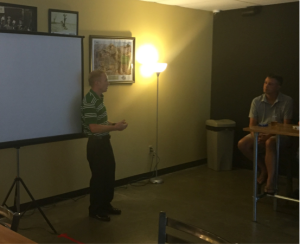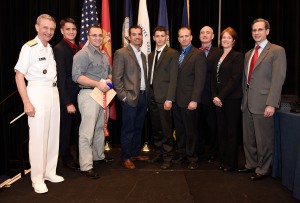By: LT Lindsey Beates and LCDR Tim Bierbach
The Athena Project returned to the Southeast region with quite a lot of energy! NAS Jacksonville, NS Mayport, and NS King’s Bay all rallied to support local grassroots innovation within the Navy and their communities at large. Athena Southeast 2.0 quickly hit targeted presentations of five, within two days after placing a call out for innovative projects. In all, five presenters and four other projects were accepted for this event. The event was held on August 5, at Veterans United Brewery, a veteran-owned company in the Southside of Jacksonville.
Presenters captivated the crowd with their creative concepts and ideas, making their pitches to fellow Sailors, industry, and academia, as well as a panel of leaders in the Southeast region. The panelists were CAPT Anthony Corapi, Commodore of Patrol & Reconnaissance Wing 11, CDR James Harney, CO of Afloat Training Group Mayport, LCDR Mike Zdunkeiwiz, Training Officer for the Maritime Patrol and Reconnaissance Weapons School (MPRWS) and Chief Collins, LCPO at the MPRWS Mobile Tactical Operations Center.
Each of the projects challenged existing paradigms in a progressive fashion, and the panelists did an exceptional job directing their questions toward challenging the weak portions of the projects while bolstering their strengths. Every question provided insight from experience and helped the presenters continue to mature their pitch and project.
In no particular order, our presenters were:
PO2 Kuhns, presenting Media Management Database
(Admiral Sims Award for Intellectual Courage – Athena Southeast 2.0)
The Media Management Database is designed to increase efficiency and quality control of the media sets required for the P-8A aircraft and media issues are currently plaguing the community, causing late departures, excessive preflight, and canceled events. The relationship between the squadrons and the Mobile Tactical Operations Centers (MTOCs) continued to be stressed while senior leadership develops a viable solution. Furthermore, combat aircrews began flying with limited standard media loads that reduce the US Navy’s overall combat capability.
PO2 Kuhns worked with VP-16 to develop a database centered on supply management and lean six sigma principals, and programed using Microsoft Access. The concept simply tracks the each piece of media, associated burning step, and location from start to storage in a near real time application. Everyone with the rights to the database now had the ability to track the applicable stages and location of the media.
This database was employed by MTOC One and VP16 as a pilot project during their inter-deployment readiness cycle and last deployment. The success was recognized immediately and media related issues were reduced, enabling MTOC One to create a more agile and adaptive process meeting the needs of the fleet. The database has the potential to be developed concurrently with SPAWAR and implemented throughout Wing 11 to increase the quality control of Media and effectiveness of the fleet. PO2 Kuhns, is stationed at Mobile Tactical Operations Center (MTOC) One at NAS Jacksonville.
PO1 Laramie Foster, presenting Test Item Analysis
Test Item Analysis is program that has taken one of the Navy’s most vital challenges – its ability to conduct self-assessments. Training, one of the Navy’s core missions, is continuously improving the measures of performance (MOP) and measures of effectiveness (MOE) that build our warfighters. The current problem for the majority of the Navy is that we are still developing and testing based on a perceptual concept and not a systematic process. Test Item Analysis empowers the average sailor and improves our for Navy Instructional system design environments.
PO1 Foster’s program uses a visual basic to generate pre-populated templates to reduce the manual effort and increase the ease of use. The Trident Training Center uses a beta version of the program and continues to undergo a continuous improvement cycle to deliver the training desire. Using a static version during several formal courses yielded extensive improvement on time required for testing the desired outcomes and reduced to time required to achieve the desired action. This program is not just for short-term analytics but it can develop long-term history base on outcomes and desired end states.
The test item analysis is looking to begin collaboration with other unit to expand its base and sample size. Several Commands at Athena expressed interest in building pilot programs to assess the potential outcomes. PO1 Foster designed the program to be maintained at a local level and is excited to collaborate with the Fleet in the near future. PO1 Foster is stationed at the Trident Training Facility NSB Kings Bay.
LT Braz Kennedy, presenting iLOC
iLOC is a project that focuses on increasing the accuracy and timeliness of tactic, techniques and procedures (TTP) during the anti-submarine warfare (ASW). For decades, TTPs have accepted numerous errors based on the human limitation and the variables calculated. With the introduction of the P-8A and its combat system, we now have the ability to conduct rapid calculation based on amplified information to increase our warfighting effectiveness.
The Project looks to conduct incremental changes. The First stage would be achieved by developing a basic excel style application that would codify the current math and science portions of our TTPs. This spread sheet would utilize the computer as a calculator for the basic equations and while enabling the crew to alter the variables to keep pace with current tactical situation. The 2nd Stage would be to imbed this capability into the P-8A combat systems, similar to Boeing’s Flight management computer.
Currently the spreadsheet continues to be developed and reviewed by multiple Maritime Weapons and Tactics Instructors. The application has also been forwarded to the Center for Naval Analysis to begin validation. This project is a progression for Cold War system that was designed to be implemented into the P-7 program before it was canceled. LT Kennedy is stationed at VP-30 in NAS Jacksonville.
LT Doug Kettler, presenting High Velocity Learning within Maritime Patrol and Reconnaissance Force
High Velocity Learning (HVL) within Maritime Patrol and Reconnaissance Force (MPRF) looked at how to begin implementation of the CNO’s vision of HVL at every level. The project defined and dismantled the Toyota Production System (TPS) to build an initial framework to deviate. It also drew a correlation between the history of the scientific method and the application in today’s innovative culture. This Framework is vital to cultivating an agile and adaptive process throughout the MPRF at large.
Doug’s project illustrated the progression from the Aviation Tactics and Techniques Innovation Cell (ATTIC) he helped stand up at VP-16. During his tour, he designed, developed, implemented and wrote on several innovative projects that applied HVL successfully. One of his examples was a project to reduce the P-8 preflight for ASW events from 3 hours to 1.5 hours. The command targeted several key performance indicators that related to delays, analyzed the information, and put controls in place. The Project was able swarm the problem and use ideology from TPS to develop the solutions. Within one day and the 6 flights dedicated to this portion of the project they were able to achieve their goal of reducing preflight time by 50 percent and saving in excess of 135 man-hours across the 6 project events. This data was then captured and published to complete the HVL process.
Doug continues mature his framework for HVL within MPRF. Many of his projects that he worked on during his tour at V16’s ATTIC have now been published as tactics, techniques, and procedures that have been adopted throughout the fleet. LT Kettler is stationed at the Maritime Patrol and Reconnaissance Weapons School (MPRWS) in NAS Jacksonville.
LT Josh Mitchell, presenting EMW4ASW
EMW 4 ASW (Electronic Maneuver Warfare for Anti-Submarine Warfare) was a CNO Rapid Innovation Cell (CRIC) accepted project before the group was defunded. This project targets a latent vulnerability from the Cold War ASW strategy. Sonobuoys use legacy technology that operates on one of 99 channels with in a small frequency range. This constraint also limits the data rate and amount of data transferred. Sonobuoys still possess enormous potential and the fix is not difficult. Incorporating photonic into the current sonobuoys increases their combat potential in the 21st Century sensor.
LT Mitchell project looks to open the aperture by building an agile system and incorporating photonic into current sonobuoys. For minimal cost, photonic will expand sonobuoys frequency spectrum exponentially and enable them to become frequency agile. Spectrum management would now be constrained via software updated and not hardware changes. Many secondary benefits would materialize from this upgrade. Data rates, bandwidth, and encryption are just a few of the potential areas for improvement. LT Mitchell, the MPRWS, and Georgia Tech Research Institute (GTRI) have been collaborating on this project for over two years to turn EMW 4 ASW into a reality, which would be a game changer for ASW.
The project continues to look for a champion and funding to build an initial prototype. PMA-264, ASW projects, has now taken an interest in the idea but due to funding cuts the project is still in idle. GTRI estimated that the project would take less than nine months for an initial test of the concept and could support the development in the near future. LT Mitchel is stationed at the Maritime Patrol and Reconnaissance Weapons School in NAS Jacksonville.
Overall, it was a very successful evening. All of the presenters gave practical, innovative solutions to current issues facing our Navy – either at the work center, squadron, or fleet level – and the audience members learned a lot. We are looking forward to Athena South East 3.0, to be held sometime this winter!
















